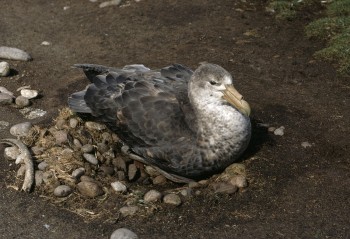Andrew Stanworth and Sarah Crofts (Falklands Conservation, Stanley) published online in 2017 a report on a 2015/16 survey of breeding sites of the Southern Giant Petrel Macronectes giganteus in the Falkland Islands (Islas Malvinas)*.
The report’s summary follows:
“A survey of key breeding sites of Southern Giant Petrels (Macronectes giganteus) within the Falkland Islands was undertaken in 2015/16. The minimum breeding population of the Islands was estimated to be 20,970 ± 180 pairs, an increase of 7.4 % since the previous census in 2004/05. Sixteen breeding sites were confirmed, supporting a minimum of 21 colonies/breeding areas; however, this figure does not account for likely additional small groups or single pairs breeding around the coasts, which were not surveyed. Based on the previous census, these small groups (constituting less than 0.5 % of the total estimated figure in 2004/05) are unlikely to significantly influence the overall population estimate. The current Falkland estimate would increase the global population estimate by 1441 breeding pairs to 48,239 breeding pairs; of which the Falklands would comprise approximately 43 %.
Of the ten key breeding sites (Key Sites) for this species at the Falklands, five had decreased, four had increased (one based on a partial count) and one remained only partially surveyed. Changes in breeding pairs at colonies ranged from a reduction of 754 pairs to an increase of 1554 pairs. Percentage change at colonies ranged between a reduction of 100 % (i.e. no colony now present), to an increase of 245 %. Average change over the eight Key Sites with complete counts was an increase by 1.6 % ± 65.3 %. The total count for sites other than Key Sites had increased by 744 pairs (57 %) since the 2004/05 census.
Major threats remain to be human disturbance and fisheries by-catch, both within the Falklands EEZ, but likely more significantly beyond it. Uncertainties around other threats, such as climatic changes/El Niño and increasing evidence of plastic ingestion in seabirds remain unknown for this species in the Islands. Population monitoring through two Island surveys (2004/05 and 2015/16), as well as annual monitoring since 2006, point towards a stable, but likely increasing breeding population of Southern Giant Petrels in the Falkland Islands.”

Breeding Southern Giant Petrel on Steeple Jason Island, Falkland Islands (Islas Malvinas)*; photograph by Ian Strange
With thanks to Andrew Stanforth and to Megan Tierney for bringing the report to my attention.
Reference:
Stanworth, A. & Crofts, S. 2017. Population Status and Trends of Southern Giant Petrels (Macronectes giganteus) in the Falkland Islands. Revised Version February 2017. Stanley: Falklands Conservation. 20 pp.
John Cooper, ACAP Information Officer, 20 September 2019
*A dispute exists between the Governments of Argentina and the United Kingdom of Great Britain and Northern Ireland concerning sovereignty over the Falkland Islands (Islas Malvinas), South Georgia and the South Sandwich Islands (Islas Georgias del Sur y Islas Sandwich del Sur) and the surrounding maritime areas.

 English
English  Français
Français  Español
Español